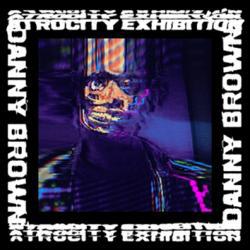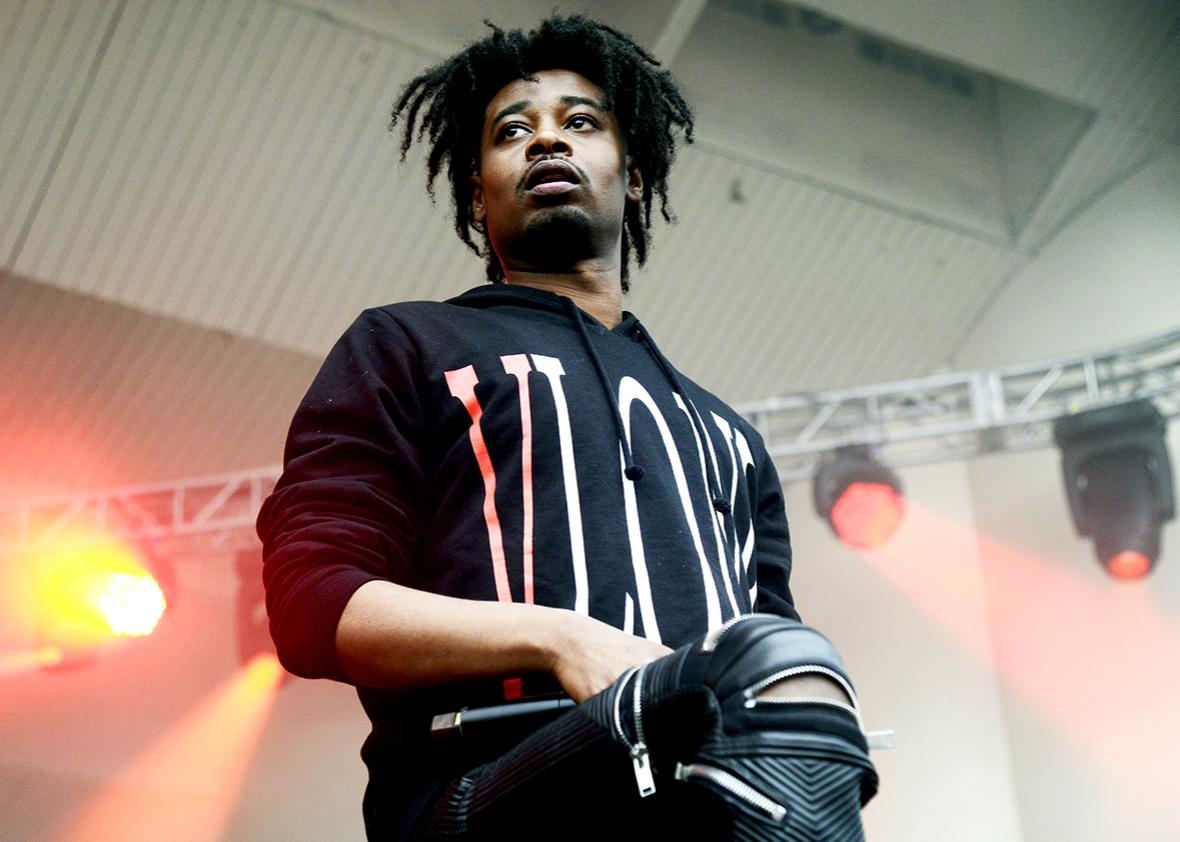The stunning new album from Detroit rapper Danny Brown opens in the terrifying space between a morning-after hangover and a night-of crack-up. The first moments of “Downward Spiral,” the opening track on Atrocity Exhibition, detail a three-day long drug binge, a debauched sexual encounter nearly derailed by erectile dysfunction, and a close brush with literal self-immolation. Brown snarls and yowls while drums, bass, and distorted guitars writhe and churn behind him. “Your worst nightmare for me is a normal dream,” raps Brown, and it sounds less like a warning than a mission statement.
Right away we know that Atrocity Exhibition isn’t going to be a run-of-the-mill rap record, and Danny Brown certainly isn’t a run-of-the-mill rap artist. “Downward Spiral” shares its name with a 1994 Nine Inch Nails album, and Atrocity Exhibition’s title is taken from a Joy Division song. (Yes, Brown is aware that The Atrocity Exhibition is also the name of a J.G. Ballard book.) Brown has always been an artist of far-flung tastes, a rapper as fluent in Radiohead’s oeuvre as Raekwon’s, and he’s long packed a rep as one of hip-hop’s most distinctive and original personalities. He hails from one of America’s greatest and most iconoclastic musical cities, the land of Motown and the MC5 and J Dilla and Eminem, and he wears this legacy loudly and proudly, working in a broad palate of yelps, yowls, bellows, and shouts. Brown’s style of rap is an acquired taste, although once acquired it’s awfully addictive: He may come off as a Mad Hatter of sorts, but he can really rap, and his live shows are nothing short of legendary.
Brown’s previous official LP, Old, was one of the best albums of 2013, a work of immense invention and versatility that was also a lot of fun. It was a party record, a weird and great one. Atrocity Exhibition strikes a different key, and finds Brown wandering down the halls of self-deconstructive avant-gardism that Future explored on last year’s DS2, but unlike that album, which stumbled through a downbeat chemical depression, Atrocity Exhibition offers a sort of Twilight Zone fun house, all distorted mirrors, darkened corners, and deranged jacks-in-the-box. Listening to the midalbum triptych of “Ain’t It Funny,” “Golddust,” and “White Lines” is like wandering into some occult circus with Brown as the white-knuckled ringmaster. The album’s closest approximation of a potential radio banger is “Really Doe,” a killer posse track produced by Detroit legend Black Milk and featuring Kendrick Lamar, Ab-Soul, and Earl Sweatshirt, spitting fire one and all, over a beat that sounds like the world’s most jittery set of wind chimes.
Perhaps it’s Brown’s maniacal vocal stylings, and perhaps it’s the dizzying, ghoulishly carnivalesque nature of much of the album’s production, but Atrocity Exhibition often recalls the spookier alleys of Tom Waits’ catalog. Like Waits, Brown is also capable of real beauty when he sets himself to it—one of the most stunning tracks on Old was “Lonely,” a gorgeous work of introspective quietude produced by British producer Paul White and set to a sample of French-Moroccan singer Morice Benin’s “Apocalypse.” The nearest analogue on Atrocity Exhibition is the album’s last track, “Hell for It,” also produced by White—a pulsing and relentless swirl of pianos, synthesizers, and drum machines. “Got it from Motown, feel David Ruffin pain/ Wanna cry right now/ So I’m wishing that it rain,” raps Brown, in a nod to the late, great Temptations singer and the group’s 1967 hit.
Atrocity Exhibition’s greatest triumph is its production, much of it from White. The beats are oblique and suggestive, working in effortless counterpoint with Brown’s inimitable vocal style. Old was a sprawling mass of eclecticism, opening with rugged, true-school boom-bap and then winding its way to cutting-edge club cuts and MDMA-soaked bangers. It was a work that grew out of Brown’s mixtape heyday and the sort of ferocious prolificness that it takes to build one’s stardom in 21st century rap. Atrocity Exhibition is something else entirely, the sort of work that in an earlier age might have been dubbed a “concept album”—it’s remarkably unified, philosophically and conceptually cohesive even as it feels spiritually untethered and musically expansive. Nothing about this album feels like a throwback, save for the fact that, at a moment when the state of the form has never felt so amorphous and insecure, it actually feels like an album.

Warp Records
It likely won’t be for everyone, nor should it be, but it deserves and rewards adventurous listeners’ utmost attention. Hip-hop has never shied away from drugs, as topic or muse, but the past year or so has seen a creative explosion in the depiction of chemical consumption and its various implications and ends, from Future’s lean-induced trilogy of Beast Mode, 56 Nights, and DS2, to ASAP Rocky’s acid-laced At.Long.Last.ASAP, to Brown’s high-strung, strung-out opus.
But in all these titles the drugs are a red herring of sorts—in art as in life, they’re a tool for self-exploration more than an end in themselves. Like Future’s music but also Kendrick Lamar’s decidedly more sober To Pimp a Butterfly, Atrocity Exhibition feels of a piece with a post-Yeezus strain of hip-hop that uses musical and vocal experimentalism to radically deconstruct notions of the self: It’s art that puts the artist under a microscope, but only after slipping a kaleidoscopic lens into the eyepiece.
And yet Brown eschews both the warbly Auto-tune of Future and the techno-vocal manipulations of Kendrick; the fragmentation and reconstitution that takes place here is entirely found in the interplay of Brown’s own voice and the exquisite work of his production partners. As such Atrocity Exhibition’s exploration of subjectivity feels open and new, its sonic and spiritual rawness rooted in something more complex than straight confession.
Hip-hop’s leading confessional rapper, of course, isn’t Future or Kanye or Kendrick, but Drake. For the past five years or so, Aubrey Drake Graham has been in the vanguard of male vulnerability in rap, his open-wounded style alternately thrilling or cloying, sometimes depending on what decade you happened to be born in. And yet despite its utter commercial domination, Views was a mildly disappointing record to my ears, the first Drake album that sounded pretty much exactly as I expected it to. Perhaps when self-revelation hardens into a brand, it ceases to be all that revelatory.
Atrocity Exhibition, on the other hand, is an album of stories, some of which may be actual facts and others of which may be apocrypha. Most of us don’t turn to music for documentary, but rather for truth—the very best hip-hop has always played with this distinction—and Brown has made some of the best and most honest hip-hop you’ll hear this year. What starts off promising to be a nightmare might be his dream, but by the end of this remarkable album it’s ours as well.
